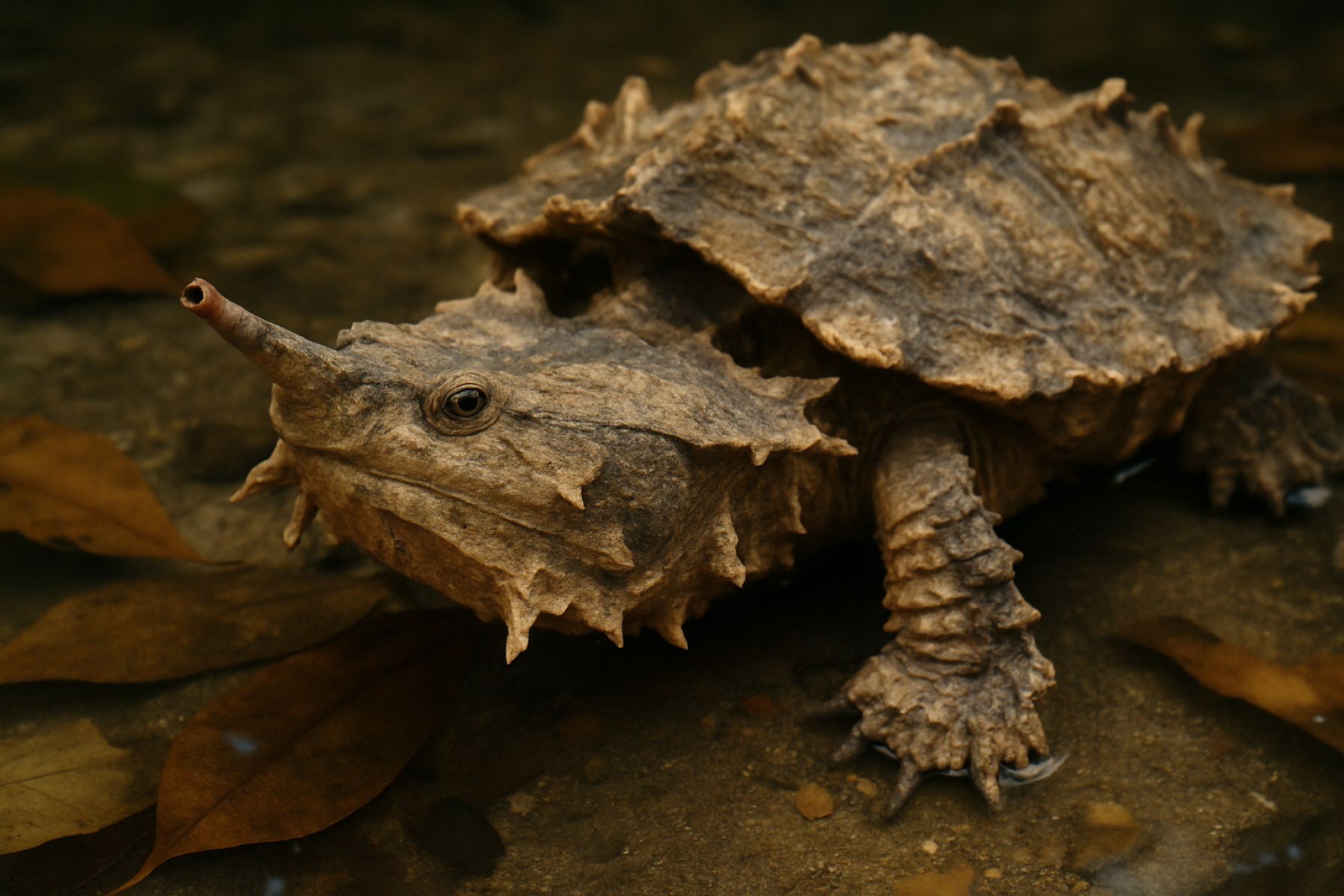Unmasking the Matamata Turtle: The Bizarre, Camouflaged Predator of South American Waters. Discover How This Ancient Reptile Thrives Through Stealth and Adaptation.
- Introduction to the Matamata Turtle
- Unique Physical Features and Camouflage
- Habitat and Geographic Distribution
- Feeding Behavior and Hunting Techniques
- Reproduction and Life Cycle
- Conservation Status and Threats
- Fascinating Facts and Myths
- Role in Ecosystem and Human Culture
- Sources & References
Introduction to the Matamata Turtle
The Matamata turtle (Chelus fimbriata) is a highly distinctive freshwater turtle native to the slow-moving rivers, swamps, and marshes of the Amazon and Orinoco basins in South America. Renowned for its bizarre appearance, the Matamata is easily recognized by its flattened, triangular head, elongated neck adorned with skin flaps, and a rough, knobby carapace that provides exceptional camouflage among leaf litter and submerged debris. This unique morphology not only aids in concealment from predators but also plays a crucial role in its ambush predation strategy, allowing the turtle to remain motionless and virtually invisible to unsuspecting prey.
Unlike most turtles, the Matamata is a specialized suction feeder, relying on rapid expansion of its throat to create a vacuum that draws in small fish and aquatic invertebrates. Its cryptic coloration and sedentary lifestyle make it a master of stealth, rarely needing to chase prey actively. The Matamata’s evolutionary adaptations have fascinated herpetologists and evolutionary biologists alike, as its appearance and feeding mechanisms are unlike those of any other turtle species.
Despite its remarkable adaptations, the Matamata faces threats from habitat destruction, pollution, and the illegal pet trade. Conservation efforts are increasingly important to ensure the survival of this enigmatic species in the wild. For more detailed information on the Matamata turtle’s biology and conservation status, refer to resources provided by the International Union for Conservation of Nature and the Smithsonian’s National Zoo & Conservation Biology Institute.
Unique Physical Features and Camouflage
The Matamata turtle (Chelus fimbriata) is renowned for its extraordinary physical adaptations, which serve both as effective camouflage and as tools for survival in its native slow-moving South American waters. Its most striking feature is the highly flattened, triangular head adorned with numerous skin flaps, tubercles, and ridges. These appendages break up the outline of the head, mimicking the appearance of decaying leaves and aquatic debris, allowing the turtle to blend seamlessly into its environment. The turtle’s wide, leaf-shaped carapace, covered in knobby, rough scutes, further enhances this illusion, making it nearly indistinguishable from the substrate of muddy riverbeds and swamps National Geographic.
The Matamata’s coloration—typically a mottled mix of browns, yellows, and blacks—complements its physical texture, providing additional concealment from both predators and prey. Its long, tubular snout functions as a snorkel, allowing the turtle to breathe while remaining almost entirely submerged and motionless. This adaptation is crucial for its ambush predation strategy, as the Matamata relies on stealth rather than speed to capture prey. When a fish comes within range, the turtle rapidly opens its large mouth, creating a powerful suction that draws the prey in whole Encyclopædia Britannica.
These unique morphological traits not only exemplify the Matamata’s evolutionary specialization but also highlight the intricate relationship between form, function, and habitat in the animal kingdom.
Habitat and Geographic Distribution
The Matamata turtle (Chelus fimbriata) is a highly specialized freshwater species native to the slow-moving rivers, swamps, and marshes of northern South America. Its primary range encompasses the Amazon and Orinoco river basins, extending across countries such as Brazil, Venezuela, Colombia, Ecuador, Peru, and Bolivia. The species is particularly associated with blackwater environments—waterways rich in tannins and organic matter, which provide the murky, leaf-littered conditions ideal for its camouflage and ambush hunting strategy International Union for Conservation of Nature.
Matamata turtles prefer shallow, slow-flowing or stagnant waters, often with dense aquatic vegetation and abundant submerged debris. These habitats offer both protection from predators and ample opportunities to ambush prey. The turtle’s cryptic appearance, resembling bark and leaves, is an evolutionary adaptation to these environments, allowing it to remain undetected by both predators and prey Encyclopædia Britannica. Seasonal flooding in the Amazon and Orinoco basins expands their available habitat, enabling the turtles to disperse into temporarily inundated forests and floodplains during the wet season.
Despite their wide distribution, Matamata turtles are rarely encountered due to their secretive nature and preference for remote, inaccessible habitats. Habitat degradation, pollution, and collection for the pet trade pose localized threats, but the species is not currently considered globally threatened. Ongoing habitat monitoring and protection are essential to ensure the long-term survival of this unique turtle in its native range Convention on International Trade in Endangered Species of Wild Fauna and Flora (CITES).
Feeding Behavior and Hunting Techniques
The Matamata turtle (Chelus fimbriata) exhibits highly specialized feeding behavior and hunting techniques that distinguish it from other freshwater turtles. Native to slow-moving rivers and swamps of the Amazon and Orinoco basins, the Matamata is an ambush predator, relying on its remarkable camouflage and stillness to capture prey. Its rough, leaf-like appearance allows it to blend seamlessly with submerged vegetation and detritus, making it nearly invisible to unsuspecting fish.
Rather than actively pursuing prey, the Matamata remains motionless, waiting for small fish or aquatic invertebrates to approach. When prey comes within striking distance, the turtle employs a rapid suction feeding mechanism. It suddenly opens its large, wide mouth, creating a powerful vacuum that draws water and prey inside almost instantaneously. The jaws then snap shut, and the turtle expels the excess water, swallowing the captured prey whole. This feeding method is highly effective in the murky, debris-filled waters where the Matamata resides, as it minimizes movement and disturbance that could alert potential prey.
The Matamata’s hunting strategy is supported by its anatomical adaptations, including a flattened, triangular head, a wide mouth, and a long, flexible neck. These features enhance its ability to create a strong suction force and to strike with precision. The turtle’s sensory barbels and skin flaps also help detect vibrations and movements in the water, further aiding in prey detection. This unique combination of camouflage, patience, and specialized feeding mechanics makes the Matamata one of the most fascinating ambush predators among aquatic reptiles (Smithsonian's National Zoo & Conservation Biology Institute; Animal Diversity Web).
Reproduction and Life Cycle
The reproduction and life cycle of the Matamata turtle (Chelus fimbriata) are characterized by unique adaptations to their aquatic environments in slow-moving rivers and swamps of South America. Mating typically occurs during the rainy season, when water levels rise and turtles become more active. Males court females through a series of head movements and by extending their limbs, a behavior thought to attract mates in the murky waters they inhabit. After successful copulation, females lay clutches of 12 to 28 eggs on land, usually in sandy or muddy banks above the waterline. The eggs are relatively large and have a hard shell, which helps protect them from predators and environmental fluctuations.
Incubation lasts approximately 200 days, with temperature playing a crucial role in embryonic development. Unlike some other turtle species, there is no evidence that temperature determines the sex of hatchlings in Matamata turtles. Upon hatching, juveniles are fully independent and immediately return to the water, where they begin their solitary lives. Growth is slow, and sexual maturity is reached at around 5 to 7 years of age. The Matamata’s cryptic appearance and sedentary lifestyle help juveniles avoid predation during these vulnerable early years.
Despite their specialized reproductive strategies, little is known about their breeding success in the wild, and more research is needed to understand population dynamics and threats to their life cycle. Conservation efforts are increasingly important as habitat loss and illegal pet trade pose risks to their survival (International Union for Conservation of Nature).
Conservation Status and Threats
The Matamata turtle (Chelus fimbriata) is currently classified as “Least Concern” by the International Union for Conservation of Nature (IUCN), reflecting its relatively wide distribution across the Amazon and Orinoco basins. However, this status belies a number of emerging threats that could impact populations in the future. Habitat destruction, particularly from deforestation and wetland drainage for agriculture and urban development, poses a significant risk to the aquatic environments the Matamata depends on. Pollution from mining and agricultural runoff further degrades water quality, affecting both the turtles and their prey base.
Another growing concern is the illegal pet trade. The Matamata’s unique appearance makes it highly sought after by exotic pet enthusiasts, leading to unsustainable collection from the wild in some regions. Although international trade is regulated under Appendix II of the Convention on International Trade in Endangered Species of Wild Fauna and Flora (CITES), enforcement can be inconsistent, and illegal trafficking persists. Additionally, climate change may alter rainfall patterns and water levels in the Amazon and Orinoco basins, potentially disrupting breeding and feeding habitats.
Conservation efforts for the Matamata turtle focus on habitat protection, stricter enforcement of wildlife trade regulations, and public education to reduce demand in the pet trade. Continued monitoring of population trends and threats is essential to ensure that this distinctive species remains secure in its natural habitat. Collaborative international action will be key to addressing the cross-border nature of many threats facing the Matamata turtle.
Fascinating Facts and Myths
The Matamata turtle (Chelus fimbriata) is renowned for its bizarre appearance and unique hunting strategy, which have inspired both scientific fascination and local myths. Its flattened, triangular head, adorned with skin flaps and tubercles, mimics leaf litter, providing exceptional camouflage in the slow-moving streams and swamps of the Amazon and Orinoco basins. This cryptic look has led indigenous peoples to believe the Matamata possesses mystical powers, sometimes associating it with spirits of the water or forest. In reality, these adaptations are evolutionary marvels that aid in ambush predation: the Matamata remains motionless, luring unsuspecting fish close before rapidly expanding its throat to create a vacuum, sucking prey into its mouth in a split second—a feeding method known as suction feeding (National Geographic).
Despite its intimidating visage, the Matamata is harmless to humans and rarely leaves the water. Its peculiar appearance has also sparked myths that it is venomous or dangerous, but these are unfounded. Another fascinating fact is its longevity; Matamata turtles can live for several decades in captivity, with some individuals surpassing 35 years (Encyclopædia Britannica). The turtle’s unique look and behavior have made it a subject of curiosity in the exotic pet trade, though its specialized needs make it challenging to keep outside its natural habitat. The Matamata’s blend of fact and folklore continues to captivate both scientists and storytellers alike.
Role in Ecosystem and Human Culture
The Matamata turtle (Chelus fimbriata) plays a distinctive role in its native South American freshwater ecosystems. As an ambush predator, it primarily feeds on fish and aquatic invertebrates, using its unique camouflaged appearance and rapid suction feeding to capture prey. This predatory behavior helps regulate fish populations, contributing to the balance of aquatic food webs and supporting overall ecosystem health. The turtle’s presence also indicates the quality of its habitat, as it thrives in slow-moving, well-vegetated waters, making it a potential bioindicator for environmental monitoring (IUCN Red List).
Culturally, the Matamata turtle has intrigued local communities and naturalists alike due to its bizarre appearance and cryptic behavior. In some indigenous Amazonian cultures, turtles are considered symbols of longevity and wisdom, though the Matamata is less commonly used for food or traditional medicine compared to other turtle species. Its unusual look has also made it a subject of fascination in the exotic pet trade, raising concerns about over-collection and the need for sustainable management (CITES). Additionally, the Matamata’s role in ecotourism and environmental education is growing, as its unique adaptations provide compelling examples of evolutionary specialization and the importance of wetland conservation (World Wildlife Fund).
Sources & References
- International Union for Conservation of Nature
- Smithsonian’s National Zoo & Conservation Biology Institute
- Animal Diversity Web











